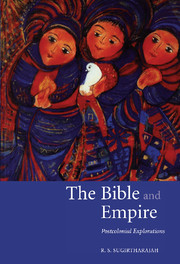Book contents
- Frontmatter
- Contents
- Acknowledgements
- Introduction
- 1 Textually conjoined twins: Rammohun Roy and Thomas Jefferson and their Bibles
- 2 Salvos from the Victorian pulpit: conscription of texts by Victorian preachers during the Indian rebellion of 1857
- 3 Thorns in the crown: the subversive and complicit hermeneutics of John Colenso of Natal and James Long of Bengal
- 4 Texts and Testament: the Hebrew scriptures in colonial context
- 5 Imperial fictions and biblical narratives: entertainment and exegesis in colonial novels
- Afterword
- Select bibliography
- Index of biblical references
- Index of names and subjects
Introduction
Published online by Cambridge University Press: 02 December 2009
- Frontmatter
- Contents
- Acknowledgements
- Introduction
- 1 Textually conjoined twins: Rammohun Roy and Thomas Jefferson and their Bibles
- 2 Salvos from the Victorian pulpit: conscription of texts by Victorian preachers during the Indian rebellion of 1857
- 3 Thorns in the crown: the subversive and complicit hermeneutics of John Colenso of Natal and James Long of Bengal
- 4 Texts and Testament: the Hebrew scriptures in colonial context
- 5 Imperial fictions and biblical narratives: entertainment and exegesis in colonial novels
- Afterword
- Select bibliography
- Index of biblical references
- Index of names and subjects
Summary
One of the celebrated colonial clichés is that the Bible and the gun go together and that they are almost inextricably linked. One story goes even further, in which the Bible and the gun are literally conjoined. William Colenso (1826–99), who worked as a printer in New Zealand and was a cousin of John Colenso, of whom we will hear later in this volume, picked up a cartridge fashioned out of pages from a Bible. The rolled-up paper came from 2 Samuel and bore the words ‘How long have I to live?’ (19.34). The cartridge of rolled-up biblical verses gives a slightly different meaning to the phrase ‘militant reading’, an idea later to be popularized in liberation hermeneutics.
This volume is about what happens to colonial artefacts such as the Bible, beer, a gun and a printing press, and especially, in our case, the Bible, when it is imposed forcefully on the ‘natives’, or offered to them for their benefit. It is about the Bible and its readers and their troubled journey through colonialism. It assembles essays which demonstrate how the Bible has been used in a variety of ways by both the colonizer and the colonized. It brings to the fore personalities and issues which are seldom dealt with within the parameters of mainstream biblical scholarship. It is an attempt to retrieve hermeneutical and cultural memories in both western and nationalist discourses.
- Type
- Chapter
- Information
- The Bible and EmpirePostcolonial Explorations, pp. 1 - 8Publisher: Cambridge University PressPrint publication year: 2005

